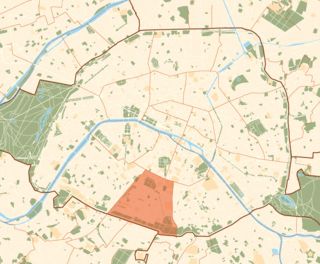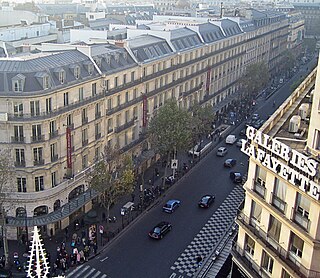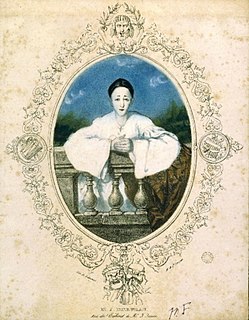
The 14th arrondissement of Paris, officially named arrondissement de l'Observatoire, is one of the 20 arrondissements of the capital city of France. It is situated on the left bank of the River Seine and contains most of the Montparnasse district. Although today Montparnasse is best known for its skyscraper, the Tour Montparnasse, and its major railway terminus, the Gare Montparnasse, these are both actually located in the neighboring 15th arrondissement. The district has traditionally been home to many artists as well as a Breton community, arrived at the beginning of the 20th century upon the creation of the Montparnasse railway terminus.

The 9th arrondissement of Paris is one of the 20 arrondissements of the capital city of France. In spoken French, this arrondissement is referred to as neuvième.

Children of Paradise is a two-part 190-minute romantic drama film by Marcel Carné made under war conditions in 1943, 1944, and early 1945 in both Vichy France and Occupied France. Set in the theatrical world of 1830s Paris, it tells the story of a courtesan and four men — a mime, an actor, a criminal and an aristocrat — who love her in entirely different ways.

Jean-Gaspard Deburau, sometimes erroneously called Debureau, was a Bohemian-French mime. He performed from 1816 to the year of his death at the Théâtre des Funambules, which was immortalized in Marcel Carné's poetic-realist film Children of Paradise (1945); Deburau appears in the film as a major character. His most famous pantomimic creation was Pierrot—a character that served as the godfather of all the Pierrots of Romantic, Decadent, Symbolist, and early Modernist theater and art.

Marcel Albert Carné was a French film director. A key figure in the poetic realism movement, Carné's best known films include Port of Shadows (1938), Le Jour Se Lève (1939), The Devil's Envoys (1942) and Children of Paradise (1945), the last of which has been cited as one of the greatest films of all time.

The Boulevard du Temple, formerly nicknamed the "Boulevard du Crime", is a thoroughfare in Paris that separates the 3rd arrondissement from the 11th. It runs from the Place de la République to the Place Pasdeloup, and its name refers to the nearby Knights Templars' Temple where they established their Paris priory.

The Théâtre de la Gaîté, a former Parisian theatre company, was founded in 1759 on the boulevard du Temple by the celebrated Parisian fair-grounds showman Jean-Baptiste Nicolet as the Théâtre de Nicolet, ou des Grands Danseurs. The company was invited to perform for the royal court of Louis XV in 1772 and thereafter took the name of Grands-Danseurs du Roi. However, with the fall of the monarchy and the founding of the First French Republic in 1792, the name was changed to the less politically risky Théâtre de la Gaîté. The company's theatre on the boulevard du Temple was replaced in 1764 and 1808, and again in 1835 due to a fire. As a result of Haussmann's renovation of Paris, the company relocated to a new theatre on the rue Papin in 1862, and the 1835 theatre (pictured) was subsequently demolished.
The culture of Paris concerns the arts, music, museums, festivals and other entertainment in Paris, the capital city of France. The city is today one of the world's leading business and cultural centers; entertainment, music, media, fashion, and the arts all contribute to its status as one of the world's major global cities.

The Théâtre Déjazet is a theatre on the boulevard du Temple in the 3rd arrondissement of Paris, France. It was founded in 1770 by Comte d'Artois who later was crowned Charles X. It was then closed down and not reopened until 1851. At that time it became a café-concert called the Folies-Mayer, on the site of a former jeu de paume. It was converted into the Folies-Concertantes in 1853, and reopened as the Folies-Nouvelles on 21 October 1854.

Christian Perrin, known by his stage-name Christian, was a French actor and singer in operetta, born in Paris, 1 January 1821, and died there in December 1889. He had a long and successful career in Paris from the 1850s up to his death.

In 1862 during Haussmann's modernization of Paris the Théâtre de la Gaîté of the boulevard du Temple was relocated to the rue Papin across from the Square des Arts et Métiers. The new theatre, built in an Italian style to designs of the architects Jacques-Ignace Hittorff and Alphonse Cusin, opened on 3 September.

The Théâtre des Funambules was a former theater located on the boulevard du Temple in Paris, sometimes called the Boulevard du Crime. It was located between the prominent Théâtre de la Gaîté, and the much smaller Théâtre des Délassements-Comiques.
This article presents the main landmarks in the city of Paris within administrative limits, divided by its 20 arrondissements. Landmarks located in the suburbs of Paris, outside of its administrative limits, while within the metropolitan area are not included in this article.

Mariquita, often referred to as Madame Mariquita, (1838–1922) was an Algerian-born dancer who became a successful choreographer and ballet mistress at various theatres in Paris from the 1870s until 1920.

Jean Gautherin was a French sculptor particularly known for his marble and bronze statues commissioned by the City of Paris.
Benjamin Antier, real name Benjamin Chevrillon,, was a 19th-century French playwright.
Alphonse Adolphe Cusin was a French architect, a student of Alfred de Dreux.

Maria Conchita Gélabert (1857–1922) was a lyrical artist and actress of Spanish origin who performed in France at the end of the 19th century.

Portrait of Marguerite de Conflans is a c.1876 oval oil on canvas portrait by the French painter Édouard Manet. It is owned by the Musée d’Orsay, though it is on display in the red salon at the Musée des Augustins in Toulouse. Like A Bar at the Folies-Bergère, the work mimics Ingres in its use of a mirror to show the figure from several angles, a motif rarely used by Manet.















